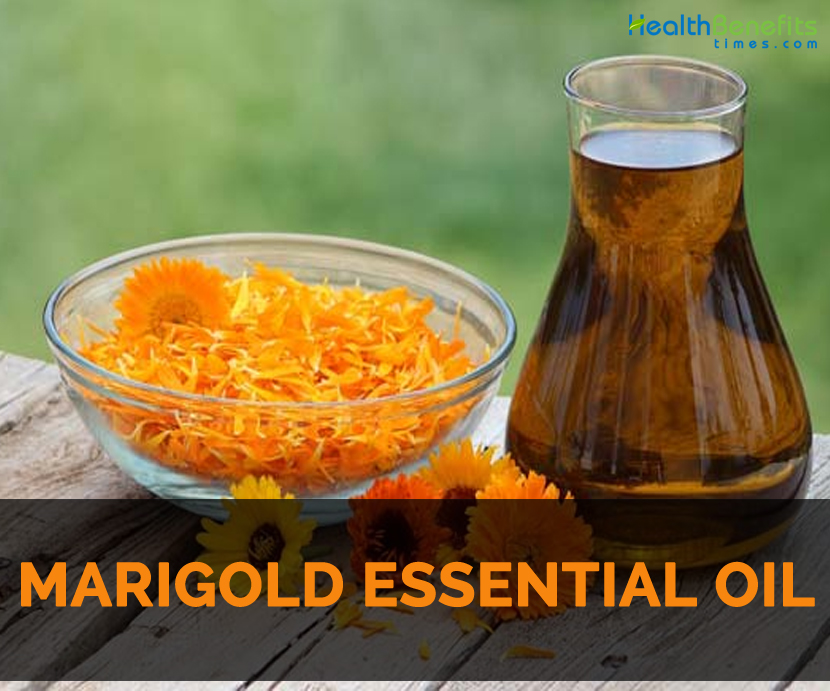| Marigold essential oil facts and benefits Quick Facts | |
|---|---|
| Name: | Marigold essential oil facts and benefits |
| Origin | Marigold is inherent to South and Central America (especially Mexico). Then it was spread in 16th century to the various parts of the world. In 16th century, it got introduced to Spain and was widely known in Southern Europe. |
| Colors | Dark greenish to brown |
| Health benefits | Anti-parasitic effect, Prevent microbe growth, Prevent infection, Antibiotic property, Relaxant properties |
History
Marigold is inherent to South and Central America (especially Mexico). Then it was spread in 16th century to the various parts of the world. In 16th century, it got introduced to Spain and was widely known in Southern Europe.
Health Benefits of Marigold essential oil
Marigold scientifically known as Tagetes Minuta belongs to Compositae family. Marigold essential oil possess sweet, strong, fruity and citrus like aroma and widely used to treat foot problems and infections.
- Antiparasitic effect
Marigold essential oil helps to eliminate fleas, mosquitoes, bed bugs and lice from the human body. It also neutralizes the effects of stings and bites.
- Prevent microbe growth
Marigold essential oil prevents the microbe growth in the body and its infections as well. It also cures dermatitis, skin ailments, malaria, typhus, tetanus, septic, cholera, athlete’s foot, food poisoning which are caused by protozoa, fungi and bacteria.
- Prevent infection
It prevents the infection caused by Staphylococcus Aureus that could be fatal and dangerous that could lead to the symptoms such as extreme spasms, convulsions, swelling with redness, muscular contractions, insanity and immobility of limbs.
- Antibiotic property
The antibiotic property in Marigold essential oil prevents the growth of fungi, bacteria and protozoa. It is helpful for ulcers, open sores, rotten wounds and gangrene. It also prevent maggots growth in wounds.
- Relaxant properties
It possesses relaxant properties that relaxes spasms and relieve diarrhea, coughs, convulsions and cramps.
- Disinfectant properties
Marigold essential oil possesses anti-parasitic, antimicrobial and antibiotic properties. The external use of this essential oil cures infection of the body. It prevents airborne diseases such as mumps, common cold, pox, measles etc.
- Lower inflammation
It has sedative property that helps to lower inflammation, irritation in nervous, digestive, neurotic, excretory systems, afflictions, convulsions, depression, stress, panic, anger and hyper reactions.
Traditional uses
- It helps to treat scars, eczema, rashes, cracked skin, viral infections and inflammation.
- It promotes respiratory health by facilitating decongestion in case of flu and cold.
- Topically, it is used in bath, diffuser or directly inhaled.
- Combined a few drops of Tagetes oil to treat corms, bunions and soften calluses.
- The symptoms of flu and cold could be soothed by adding a drop of Tagetes oil to the bathwater.
- Add several drops of Tagetes oil, it provides relief from coughing spasms and also dilate bronchial passages.
- It is used for whooping cough, colic, mumps and colds.
- It also cures skin ailments.
Precautions
- Pregnant women should avoid it.
- Use with a consultancy of health practitioner.
- Perform a patch test for use.
Other Facts
- It is used for manufacturing perfumes.
- It blends well with marjoram, calendula, lavender, lemon, bergamot, grapefruit, frankincense, myrrh, thyme and geranium.
- It is used to treat skin infections, weeping wounds, calluses, boils and Athlete’s foot.
- It is also used in salves, lotions, personal care products and natural cosmetics.
Marigold essential oil facts
| Name | Marigold essential oil facts and benefits |
|---|---|
| Scientific Name of Marigold plant | Tagetes minuta |
| Native | Marigold is inherent to South and Central America (especially Mexico). Then it was spread in 16th century to the various parts of the world. In 16th century, it got introduced to Spain and was widely known in Southern Europe. |
| Common names of Marigold oil | Tagetes Essential Oil |
| Common/English Name of Marigold plant | Calendula, Little calendar, Aztec marigold, African marigold, Mexican Marigold |
| Name in Other Languages of Marigold plant | Hindi: Gainda, Genda Phool, Genda; Gujarathi: Galaghoto; Bengali: Genda; Marathi: Ghenda; Kannada: Chenduhoovu, Chendu huvu; Telugu: Banti Puvuu; Malayalam: Chendu malli; Nepalese: Sayapatri; Parsi: Gulhazara; |
| Extraction method | Steam distilled |
| Part of plant used | Bright orange flowers |
| Color | Dark greenish to brown |
| Flavor/aroma | Floral |
| Scent | Fresh, fruity, herbaceous |
| Health Benefits |
|
| Traditional uses |
|
| Precautions |
|
| Other Facts |
|
References:
http://www.gritman.com/marigold-essential-oil.html
http://sedonaaromatherapie.com/blog/2015/02/02/the-different-types-of-marigold-oil/
https://www.mountainroseherbs.com/products/tagetes-essential-oil/profile
http://eagri.tnau.ac.in/eagri50/HORT281/pdf/lec40.pdf
http://www.livinglibations.com/default/marigold-essential-oil
Comments
comments
